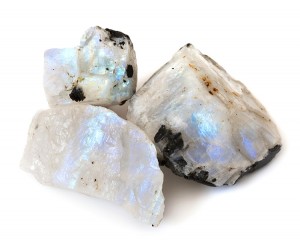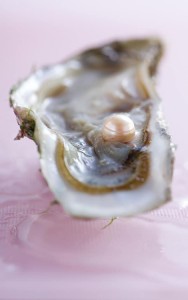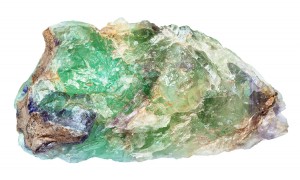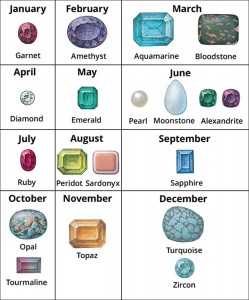June’s Gems
June 10, 2019
If your birthday is in June, you can choose between three birthstones—the gems associated with the month of your birth: alexandrite, moonstone, or pearl. Alexandrite is a rare gem variety of the mineral chrysoberyl. The most highly valued alexandrite appears green like an emerald (May’s birthstone) in natural light, but looks red like a ruby (July’s birthstone) in artificial light. Moonstone is a whitish variety of the mineral feldspar. Light will shine through moonstone, but not so clearly as through glass. The pearl is one of the most valuable gems. Large, perfectly shaped pearls rank in value with the most precious stones.
Alexandrite was first discovered in the Ural Mountains of Russia in 1833. The stone was named after Alexander II, who later became the czar of Russia. Today, alexandrite is still mined in Russia. Other countries that produce alexandrite include Brazil, Myanmar, Sri Lanka, Zambia, and Zimbabwe.

Moonstone reflects light with a bluish or pearly-colored sheen that comes from inside the stone. Credit: © J. Palys, Shutterstock
Moonstones have a metallic or iridescent luster. This optical phenomenon, called adularescence or schiller, results from light reflecting off thin layers of feldspar. The name moonstone came from ancient legends that said the gems were created by beams of light from the moon. During a full moon, the gem was thought to have strong powers that attracted good fortune or love. Today, moonstones—many of which come from Sri Lanka—commonly decorate earrings and necklaces.

This photograph shows a pearl with a rosy hue inside an open oyster. Credit: © FoodPhotography/Getty Images
Pearls are different from other gems. Most gems are minerals that are mined from beneath the earth. But pearls are formed inside the shells of oysters. Oysters and other shell-forming mollusks make a special substance, called nacre or mother-of-pearl, that lines the insides of their shells. This smooth lining is called the nacreous layer, or pearly layer, and it is often lustrous. It is formed by a fleshy body organ called the mantle. When a foreign substance, such as a bit of shell or a tiny parasite, enters the body of the mollusk, the mantle begins to work. It covers the invading substance with thin sheets of nacre. It builds successive circular layers of nacre until the foreign body is enclosed in the shell-like substance, forming the pearl.
Pearls were treasured among many ancient cultures. The often white color of the “queen of gems” has long symbolized purity, but pearls can also be “black” (dark gray), cream, gold, orange, or pink. Round pearls, suitable for necklaces, are the most valuable. Next in value are the button-shaped and drop-shaped pearls. These are often used for earrings.
Until the 1940′s, the chief pearl-oyster beds were found in the Persian Gulf, near the island country of Bahrain. Other natural pearl-oyster beds were located in the South Pacific Ocean. Thousands of oysters had to be collected to produce even a small handful of pearls. For this reason, natural pearls were extraordinarily expensive. Today, few natural pearls are harvested for jewelry because the farming of cultured pearls produces pearls more cheaply. Cultured pearls are created by oysters planted in carefully selected oyster beds. People then “encourage” pearls to form (usually within about three years) by placing tiny pellets made of nacre or mussel shell inside the oyster shells.
According to tradition, a birthstone brings good luck to a person born in its month. Each birthstone also corresponds to a sign of the zodiac. The belief in birthstones may have come from a Bible story about Aaron, the first high priest of the Israelites. The story describes Aaron’s breastplate, which was decorated with 12 precious stones. Early writers linked these stones with the 12 months of the year and the 12 signs of the zodiac. The custom of wearing a stone that represented a person’s zodiac sign probably originated in Germany or Poland in the 1700′s.




